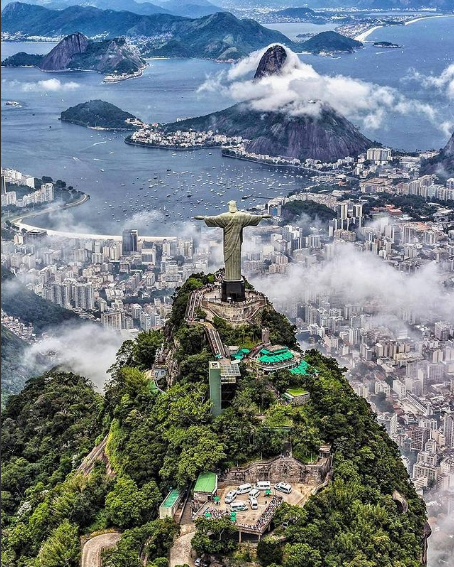Fun and Interesting facts for Brazil: In many people’s views throughout the world, Rio de Janeiro continues to be the primary emblem of Brazilian culture and history. Brazil’s booming cities, massive hydropower and industrial complexes, mines, and abundant farmlands help to propel the country to one of the world’s most important economies. On the other hand, Brazil is afflicted by significant socio-economic inequality, environmental degradation, periodic financial crises, and a political system that gets occasionally paralyzed by gridlock. Brazil is a country that has the 5th highest population on the planet, and it accounts for one-third of the population of the continent of Latin America. A large proportion of the people of Brazil are located on the country’s eastern shore.
Here are the top 20 interesting facts about Brazil:
1.) Brazil’s São Paulo has the highest GDP in the southern hemisphere
Brazil is a land of extremes, and this truth about the country only reinforces my point of view. While millions of people in Brazil struggle to survive in terrible poverty, the city of So Paulo is one of the world’s most significant financial and industrial capitals, with the highest GDP in the southern hemisphere and the highest GDP in all of Latin America. Many countries on other continents, including those in Europe, have economies far smaller than this massive South American metropolis.
Since it accounts for more than 30 percent of the country’s GDP, the city of So Paulo sets the rhythm of the Brazilian economy. The city’s gross domestic product (GDP) was around $530 billion in 2017, whereas the GDP of Mexico City was approximately $490 billion during the same period.
2.) The largest Japanese community outside of Japan is found in Brazil-Fun and Interesting Facts for Brazil
According to the United Nations, the first Japanese immigrants arrived in Brazil in 1908. The country has since grown to become the largest ethnic Japanese population outside of their native land. It is a fascinating statistic about Brazil, especially when you consider how different the two cultures are from one another. Approximately 1.5 million Brazilian Japanese live in Brazil.
3.) Brazil has many spoken languages.
There are at least 180 different languages. Even though Portuguese is the official language, the other languages are primarily spoken by around 160,000 indigenous people.
However, according to linguist Aryon Rodrigues of the National University of Brasilia (UnB), these languages are endangered because fewer than 10,000 individuals are now speaking these languages.
4.) Environmental crimes get taken seriously-Fun and Interesting Facts for Brazil
It is customary and appropriate to penalize those who commit crimes against the environment. One peculiarity of Brazilian law is that committing this type of offense on Sundays, holidays, or in the middle of the night is considered aggravating. It is because inspectors do not work during certain hours and days. The government wishes to deter individuals from committing crimes during those hours and days, hence boosting the likelihood of catching infractions during that period.
5.) racism is a touchy subject in Brazil-Fun and Interesting Facts for Brazil
In Brazil, around 9 percent of the population is of African descent, and 46 percent is considered interracial, consisting of Indigenous Brazilians, Africans, and Europeans. The economic inequality experienced by black and mixed-race individuals in Brazil, on the other hand, is frightening.
Many people believe that Brazil is a meritocracy and that racism does not exist here; after all, the country is so multicultural, how could it be otherwise? Unfortunately, the truth isn’t much more positive in this regard. Many individuals, particularly those from the top sections of our society, refuse to talk about it at all. However, an increasing number of people of all races are feeling oppressed as a result of this. So they are bringing up these and other sensitive issues in the nation, such as sexism and the macho culture, to raise awareness.
6.) The last nation in the Americas to abolish slavery was Brazil-Fun and Interesting Facts for Brazil
Brazil was the final country in the Americas to abolish slavery in 1888, making it the last country in the world to do so. Brazil was the latest country to ban such heinous practices in the nineteenth century, after all of the other countries in the western world and under tremendous pressure from Europe. Although this was a significant step toward equal rights for all races, it is essential to note that racism did not wholly disappear from the country.
7.) Silva is the most popular last name in Brazil.
In addition to being accurate in Brazil, this statistic is true in Portugal, where Silva’s last name is the most prevalent. With little more than 1 million persons in Brazil, the variety “de Silva” is ranked 22nd overall. However, the origins of both “Silva” and “da Silva” are the same. As a toponymic surname (a surname that is named after a location), it stems from the Latin word Silva, which translates as “jungle” or “forest,” respectively.
The presence of the Romans on the Iberian Peninsula led to the incorporation of Silva into the names of numerous Lusitanian families. Hundreds of years later, many of them carried the name to Brazil during colonial times. It grew to become an even larger community once slavery got abolished in the country.
8.) A politician created Brigadeiro-Fun and Interesting Facts for Brazil
What started as a political campaign has turned into a national dessert. If you don’t already know, Brigadeiro is the most popular dessert in Brazil, and it all began with the 1945 presidential elections. Because one of the candidates, a brigadier, was a favorite among female voters at the time, many women contributed to his political campaign by preparing sweets to be served during meetings. Helosa Nabuco de Oliveira made chocolate fudge truffles with sweetened condensed milk instead of regular milk since milk was unavailable due to the conflict.
The small balls were a hit, and word of them traveled fast around the country. It was named Brigadeiro since no one could think of a better name (English: brigadier).
9.) Brazilians eat more rice and beans than the national meal
Brazil’s national food, feijoada, is not as consumed as rice and beans. Some eat rice and beans twice a day. It’s simple to create this particular combo of rice and beans; that is why it is prepared daily in most families.
10.) Para is the Lonestar on the Brazilian flag-Fun and Interesting Facts for Brazil
Each of the stars on the Brazilian flag signifies a state or the capital of that state or country. Many people assume that the lone star in the upper portion of the flag represents Brasil, the country’s capital, but I can assure you that this is a standard error. In reality, that star signifies the state of Pará, which is located in northern Brazil. At the time, Pará was the northernmost state in Brazil; Amapá and Roraima were eventually founded to make out the rest of the country. And, because the positions of each state got picked based on their geographic location inside Brazil, Pará is the lone star.
11.) The stars on the flag represent November 15, 1889
The starry night depicted on the Brazilian flag, which serves as the country’s national emblem, is not just any regular night but the night of November 15, 1889, as viewed from Rio de Janeiro. On that day, a military coup d’etat brought about the establishment of the Republic of Brazil, and an astronomer was commissioned to sketch the sky above their heads to commemorate the occasion.
12.) São Paulo State’s flag could have been Brazil’s flag-Fun and Interesting Facts for Brazil
Following the country’s transformation into a republic, the people desired a new flag to symbolize a fresh beginning. A large number of initiatives got presented to the appropriate authorities at the time. Nonetheless, the present flag of Sao Paulo is one of the most well-known of the ideas that got rejected.
The state of Sao Paulo was awarded a tricolor flag, with each hue representing one of the country’s major ethnic groups due to this rejection by the federal government. The black color signifies the African slaves who helped build the country, the white color represents European immigration, and the red color represents the indigenous people who live on our lands today.
13.) Brazil has the most national parks in the Americas.
It should come as no surprise that Brazil has a plethora of national parks to explore. Even though it is a large country, it isn’t easy to get around it. However, one fascinating fact about Brazil is that it has the most national parks on the American continent. Brazil has 72 national parks spread throughout its area, with most of them located in the country’s northern region.
14.) Queimada Grande Island is the deadliest place on earth-Fun and Interesting Facts for Brazil
That is one of the places in Brazil that you will not want to visit. In reality, due to the enormous risk on this island, no one is permitted to step foot on it. Anyone planning to visit Queimada Grande Island, commonly known as Snake Island, must first obtain permission from the Brazilian Navy, follow all necessary regulations, and be accompanied by a medical professional in case of bites from snakes.
In most cases, only scientists are permitted to enter the island. It is because, as the name implies, this island is teeming with snakes. I realize this is a strange truth about Brazil. Queimada Grande Island contains around 45 poisonous snakes per 328 feet of coastline to understand better how deadly it is.
15.) In Pomerode Town in the south of Brazil, they learn a dialect of German at school.
Many Brazilians are unaware of some things about Brazil, which is one of those pieces of information. Perhaps you are unaware that many Germans emigrated to Santa Catarina and the Rio Grande do Sul throughout the twentieth century. One of the most remarkable facts about Brazil is that there are still a few German groups in the country that adhere to their cultural customs. And what’s even more incredible is that they speak a German dialect in Brazil!
16.) A replica of the Japanese temple Kinkaku-Ji is found in Brazil-Fun and Interesting Facts for Brazil
It shouldn’t come as a surprise that Sao Paulo is home to a copy of one of Japan’s most important temples, given the city’s large Japanese population. The village of Itapecerica da Serra, located a little more than an hour’s drive from the city center, is home to a lovely cinerarium.
This cinerarium is housed in a reproduction of the Japanese temple of Kinkaku-Ji, surrounded by a beautiful garden. It is a fantastic day excursion from the city of SP. This temple in Kyoto is entirely coated in gold leaf, which gives it the name Kinkaku-Ji, which translates as “Golden Pavilion” in English.
17.) The name Brazil comes from Brazilwood-Fun and Interesting Facts for Brazil
It is one of my favorite tidbits about Brazil that I learned while traveling. When the Portuguese first arrived in Brazil, the brazilwood tree could get found growing in abundance everywhere. It was a significant export good for them, and since there were so many of them, they decided to name the country after it, which became Brazil.
18.) Brazil is the only country in South America that speaks Portuguese.
Portuguese explorers arrived on Brazilian soil in 1500, and the nation remained one of their colonies for the next 322 years. They remained until 1822, when residents waged a successful independence campaign that culminated on September 7. According to the United Nations, Brazil is the only country in South America that uses Portuguese as a first language. And, except Guyana, French Guiana, and Suriname, all other countries are Spanish-speaking.
19.) Brazil is huge-Fun and Interesting Facts for Brazil
Brazil is the world’s 5th most populous country, with over 200 million people. Europe is just a tad bit larger than Brazil in terms of land area, which makes it the largest nation in South America in terms of population. The country of Brazil is not only massive, but two-thirds of the world’s Amazon Rainforest is located in the country.
20.) Home to the largest swamp
The Amazon is the world’s largest rainforest, and it is still home to the world’s largest river by volume, the Amazon River. In addition to being the world’s most unique region on the planet, Brazil is also home to the world’s largest swamp. The Pantanal is emerging as a popular tourism attraction.
If you’re a coffee drinker, the chances are good that you’ve had some Brazilian coffee this year. Because Brazil is the world’s largest producer and exporter of coffee, accounting for 30 percent of total global production, this is the situation.
There is more to Brazil than its beautiful cities and rich history. What other fun facts do you know about Brazil?
Recommended Reads
- The Amazon Rainforest in Brazil: All You Need to Know
- The Longest Beach in the World 2021
- Flag of Mexico Meaning: All You Need to Know
- Interesting Facts of Canada: Top 24
- Interesting Facts on Hawaii-Top 20


